2024..01.01.7
Files > Conference Series > 2024 > Chimboazo ild pagina nueva
Description of the primary Loreto-coca river contamination through the measurement of physicochemical parameters
Jose Allauca P1,2, Carlos Lopez P1, Jennyfer Daza1, Joyce Chamba1
1 Escuela Superior Politecnica de Chimborazo (ESPOCH), Sede Orellana, El Coca, 220101, Ecuador,
2 Instituto Superior Tecnologico General Eloy Alfaro (ISTGEA), La Joya de los Sachas, 220101, Ecuador
Escuela Superior Politecnica de Chimborazo (ESPOCH), Sede Orellana, El Coca, 220101, Ecuador
Available from. http://dx.doi.org/10.21931/BJ/2024.01.01.7
ABSTRACT
The main objective of this article is to describe the pollution in the main Loreto-Coca rivers using physicochemical parameters. Our analysis is focused on the Orellana province and examines the Suno, Napo, Coca, and Payamino rivers, which are adversely impacted by oil and mining activities. These activities result in toxic and chemical residues, such as heavy metals and other contaminants. Samples were collected following the INEN 2176 standard to do this. We could evaluate parameters such as pH, dissolved oxygen, conductivity, turbidity, nutrients (nitrates, phosphates), heavy metals, and COD using laboratory equipment and specific techniques and methods. The level of pollution was determined by comparing these results with permissible limits. Therefore, based on the comparative results obtained, environmental education is crucial for raising awareness about the importance of protecting and conserving water as a vital resource. Conducting these studies provides essential information for taking preventive and corrective measures and monitoring and addressing identified issues to safeguard public health and the environment.
Keywords: pollution, water, rivers, sample, standard, physicochemical parameters.
INTRODUCTION
Water has particular characteristics; it is fragile, scarce and essential for us living beings; it has been used as the primary issue of adaptation among the population to satisfy all its biological needs. The problem of this resource is due to the reproduction, circulation and generation of waste, including toxic-chemical waste or other particles found in the surroundings of our communities, when these pollutants enter the water, such as rivers, lakes, seas, etc. They dissolve in them, thus leaving suspended particles and even depositing at the bottom of rivers, thus causing degradation of water quality1.
The extraction, refining or use of petroleum derivatives are still part of the world's economic activities. Petroleum is a mixture of paraffin, naphthenic and aromatic hydrocarbons, benzene, sulfur, nitrogen, oxygen and metallic compounds. However, its chemical components are detrimental to the health of the communities near the oil areas, which have shown carelessness in the traces left by their petrochemical activities, mainly the contamination of water resources. To this is added deficient government surveillance. River water is the primary source of consumption for the rural population, and being contaminated by chemical compounds, it is difficult to carry out water treatment2.
The Latin American region is very rich in water resources, and people have the right to consume clean water. Drinking water is everyone's responsibility and must be ensured that it is acceptable, accessible and affordable for personal and domestic use. A safe, quality water supply is essential to prevent deaths from dehydration and reduce the risk of waterborne diseases. Therefore, it is necessary to carry out physical parameters that indicate how polluted the rivers of the Coca and Loreto cantons are to know the water quality and if humans can consume them 3.
The factors most considered as potential pollutants in Ecuador are organic and inorganic products and heavy metals that are produced by industries, the agricultural sector and urban runoff surrounding the area; all these pollutants not only cause environmental damage but also cause severe diseases to the population, organophosphates and carbonates come into contact with humans, and there is a high percentage of probability that these are the cause of chronic diseases such as cancer and damage to internal organs. The human being needs at least 3 liters of drinking water a day for his existence and about 20 liters for daily activities; in our country, we have a significant advantage since Ecuador has a quantity of fresh water of 22,500 m3/inhab/year 4.
Environmental Education (EE) is so important due to the life we lead; focusing on EE, we know that it is essential to see the issue of water as a resource that must be cared for, conserved and enjoyed rationally. Therefore, in the last decade in our country. Due to this particular context, it should be logical to expect that the province in which this study will be carried out would present a relatively higher level of awareness than it may present for other topics. However, we have not even reached 50% awareness in our province; we are far from being able to affirm this approach 5.
It is time to focus on one of the most seen problems in the province of Orellana and the affectation caused by mining activity at the provincial level; we know that it is of great importance for the productive development of our country; however, the fact that heavy metals are used for their production implies a high risk of contaminating the environment and the communities where mining is practiced. We all make use of water; therefore, we want to find a way to propose a balanced design based on the narratives about the degree of contamination to go beyond the emotions and the humanistic side of man but rather through This can contribute to the commitment of societies with the environment 6.
When we talk about the detection and quantification of heavy metals in rivers, we cover techniques, methodologies, equipment and materials, all this with planning according to the situation; this has given way to the investigation of various methods to use, comparing time, cost and accuracy of the results, mentioning some we have Atomic Absorption Spectrometry, Inductively Coupled Plasma Spectrometry, Photometric Techniques, Electrochemical Techniques, among others, each technique has different advantages and disadvantages, some have derivations for specific metals which is essential for the results, others have low cost, all this allows us to decide the scope of the investigation and the price we want to reach 7.
For decades, there has been evidence that a high percentage of diseases come from poorly processed water, that is, it does not meet the standards of water suitable for human consumption; in turn, the rivers, precisely which the project focuses on, are not clean water, but contaminated with fecal matter that affects the decrease in water quality and therefore the life of living beings, bacterial and viral diseases caused by agents are present. Another factor is the excessive presence of chemical, organic and inorganic contaminants and heavy metals from industrial and agricultural sources and urban runoff, alterations in the nervous and immune systems, damage to the human genome and the product of reproduction 8.
With water quality evaluation, we refer to the substrate's chemical, physical and biological characteristics to be analyzed. Towards the tributaries of the Loreto-Coca rivers in the province of Orellana, we will require the widely known Water Quality Index (QWI). Still, first we will analyze the study of 5 physical-chemical parameters to determine the degree of contamination in the collection area. According to each river, all kinds of standardized norms will be carried out to collect the sample, transport it, and determine results; with this, we will have an adequate value to continue comparing the degree of contamination of the rivers mentioned above 9.
The contamination of rivers in the Orellana province in Ecuador is a matter of great concern for residents and government authorities. The province is located in the Amazon region of the country, which is one of the most biodiverse areas in the world and has significant ecological and economic importance. However, human activity, such as oil exploitation, agriculture and livestock, has caused a series of environmental problems, including the pollution of rivers.
According to a study 10, Orellana's rivers are contaminated with heavy metals, such as lead, mercury and cadmium, due to mining and oil activity. These metals can have toxic effects on human health and aquatic ecosystems. In addition, agriculture and livestock also contribute to the contamination of rivers with pesticides and fertilizers.
Another study carried out 11 found high levels of contamination in the Napo River, which runs through the province of Orellana. The contamination included high levels of fecal coliforms and other chemical contaminants, which can negatively affect human health and aquatic fauna.
Local and national authorities have implemented measures to address river pollution in Orellana, including regulating mining and oil activity and promoting sustainable agricultural practices. However, more decisive action is required to protect human health and the environment.
In the Unified Text of Secondary Environmental Legislation 12, Book VI Annex 1, we can find norms and regulatory standards for protecting and controlling water resources. The tables above contain water quality criteria for human consumption, aquatic and wildlife life preservation, agricultural irrigation, livestock use, and recreational use through contact and effluent discharge into the sewer, freshwater bodies and seawater.
Evaluating the physicochemical parameters of water is crucial to determining the level of contamination in water bodies. As indicated 13, these parameters make it possible to measure the presence of chemical substances and organic compounds that can harm human health and the environment. Early identification of contaminants helps to take preventive and corrective measures to avoid more significant problems. In addition, the periodic measurement of physicochemical parameters allows for monitoring the evolution of water quality and evaluating the effectiveness of environmental management policies and programs.
The detection of pH and electrical conductivity are vital parameters to determine the level of contamination in rivers, according to the authors 14 in their study on the monitoring of physicochemical parameters in the upper basin of the Bogotá River. The pH measurement allows us to know the water's acidity or alkalinity and detect the presence of acidic or basic substances that can affect the quality of the water and aquatic life. Electrical conductivity indicates the amount of dissolved salts in water and can indirectly infer the presence of organic and inorganic substances in water. Both parameters are essential to assess the impact of human activities on rivers.
The study carried out 15 on the physicochemical and microbiological evaluation of the water quality of the Machangara and Monjas rivers of the Quito metropolitan district (DMQ) water network is relevant due to its contribution to the identification of contamination levels in these rivers through the measurement of physicochemical and microbiological parameters. The information obtained through this study is helpful for decision-making regarding the management and conservation of the water of these rivers and, therefore, for the protection of the environment and public health.
Detecting heavy metals in river sediments is important to determine water quality and assess environmental impact. The digestion process is essential in this analysis since it allows the extraction of metals in the sediment and its subsequent quantification. The EPA Standard is a tool to establish allowable limits for metals in surface waters and sediments. The study carried out in 16 in the Puyango River basin, Ecuador, demonstrates the application of this methodology to assess the levels of heavy metals in river sediments.
Standard methods 17 for analyzing drinking water and wastewater are essential for determining water quality. Methods used include Method 2550-B for the determination of total solids, Method 2540-B for the determination of suspended solids, Method 2510-B for the determination of settleable solids, and Method 5220-D for the determination of dissolved oxygen. These methods provide detailed information on contaminants present in water and their concentration, allowing informed decisions to protect public health and the environment.
The advantage of using physicochemical water quality parameters is that the information obtained during monitoring can be easily transferred and interpreted. The indicator shows the level of contamination of the type of water tested, allowing the user to understand the water situation quickly. It can be excessive, moderate or non-existent, understandable and abstract; the studies of the characteristics of the water bodies quantify and simply present results that generate general or specific perceptions of the state of each case study so that measures can be taken to improve the general conditions of the bodies of water 18.
Most studies include physicochemical parameters, BOD variables, total coliform counts, and percent oxygen saturation. These first two variables reflect different sources of organic pollution, and the last variable represents the environmental response to varying types of pollution. The importance of using specific organisms as biological indicators is emphasized because these organisms occupy habitats that must meet specific environmental requirements. Therefore, when carrying out studies that involve physicochemical and biological parameters, conclusions can be drawn based on water quality 19.
The choice and use of these tools require a deep knowledge of various physical and chemical variables and their interactions with the biological communities that inhabit this type of ecosystem. Physicochemical parameters such as pH, temperature, conductivity and dissolved oxygen are measured, among others, in bodies of water; it is probably the easiest way to define changes in their composition. These parameters also contain information on the evaluation of chemical and biological processes, which suggests that it can also help to identify geochemical processes such as self-purification 20.
Those studies that have served the scientific community to determine the level of contamination of natural water effluents are one of the main tools for remedying, purifying, and even preventing the contamination of this resource. Next, friendly options with the environment that can be implemented are disclosed.
Bioremediation: It is the application of microorganisms, plants and fungi that have the enzymatic capacity to degrade molecules that affect the natural composition of either water or soil 21.
We find specific applications within this field according to the species used.
· Phytoremediation: It uses plants to remove or degrade the contaminants in the place of interest 22.
· Mycoremediation: Use of fungal organisms due to their tolerance to contaminated systems; they also mineralize contaminants and spread quickly through their hyphae 23.
An important step is the implementation of treatment plants used by oil companies. It would not reduce pollution on a large scale, but control of the waste generated within the oil fields would be maintained. In turn, campaigns and contributions from the companies must be developed. They carry out oil extraction in extremely low-resource communities, the same ones that are affected; all this contamination goes hand in hand with the human being; the waste and detachment of crude oil generates diseases and causes damage to the skin, contributing to bioremediation a One step ahead of pollution, the damage to marine life is closer to becoming extinct 24.
Investigating different research areas, we found some alternatives for bioremediation in freshwater applied to heavy metals. The problem in the river is due to the high degree of contamination by heavy metals in these waters. The possibility of using microalgal biomass as a bioremediation agent for the purification of water contaminated with PM (Particulate matter) has demonstrated the effectiveness of four green microalgae species (Chlamydomonas reinhardtii, Chlorella vulgaris, Scenedesmus almeriensis and Chlorophyceae sp., isolated from the Loa River). These biological purification processes on the elements As, B, Cu, Mn and Zn, present in aqueous solutions, gave us good results by analyzing the operation factors and integration processes25.
In the mineral extraction process, using large quantities of reagents such as cyanide and mercury is unavoidable and highly toxic to our environment. Today, the mining industry uses many methods to decontaminate cyanide effluents, such as The characterization of Cecropia peltata l. and Malva sylvestris; with both plants, a percentage of cyanide removal of 17% was obtained with Malva sylvestris and with Cecropia peltata l, 12%. On the other hand, when doing dosage tests, 14% and 11% removal percentages were obtained with the aqueous extracts. This treatment not only helps to decontaminate effluents, it also serves as a cost-reduction treatment since this type of plant is found in large numbers in our country 26.
Bioremediation is essential to act on the contamination of one or several rivers, for which microbial processes used for the recovery of soils contaminated by metals are employed so that the cleaning of degraded soils is an efficient process, optimal conditions must be biodegradation, taking into account the variables of humidity, pH and oxygen, through the inoculation process of bacteria of the genus Rhizopus, Penicillium and Phanerochaete, in addition, there is an extended field of bacteria capable of using hydrocarbons as a carbon source for their metabolic functions, being the most known genera, with biodegrading capacity: Achromobacter, Acinetobacter, Alcaligenes, Arthrobacter, Aspergillus, Bacillus, Brevibacterium, Candida, Corynebacterium, Flavobacterium, Fusarium, Micrococcus, Mucor, Mycobacterium, Nocardia, Penicillium, Pseudomonas, Rhodococcus, Rhodotorula, Sporobolomyces, Stenotrophomonas 27.
River pollution is a major environmental problem, and over the years, numerous scientific studies have contributed innovative ideas to remedy this situation. Among these studies is research that has explored the use of aquatic plants and bacteria to mitigate river pollution. Next, I will mention some relevant scientific articles in this field, along with the bacteria or plants mentioned:
1. They demonstrated that the aquatic plant Pistia stratiotes (water lettuce) can remove pollutants in the Tinto River 28.
2. They investigated the Lemna minor plant (duckweed) 's potential for removing heavy metals in a polluted river 29.
3. They evaluated the capacity of the bacterium Pseudomonas aeruginosa to degrade hydrocarbons in a polluted river 30.
4. They studied the ability of the bacterium Bacillus subtilis to degrade organic compounds in a polluted river 31.
These are just a few examples of the wide range of scientific research that has provided ideas for remediating river pollution using aquatic plants and bacteria. These studies demonstrate the potential of nature to deliver sustainable solutions to the environmental challenges we face.
Advances in the industrial sector have increased pollution by releasing toxic compounds such as chromium (VI) deposited in water and soil. Due to this problem, alternative methods of managing these resources have been developed to reduce their environmental impact. This algorithm identifies microbial communities based on their taxonomic and functional profiles, which can be used for bioremediation of polluted rivers to increase remediation efficiency by analyzing the practical characteristics of microbial communities.
The issues of awareness and care for the environment do not have as much value as they should be at present, and the threat to the planet will never cease to exist; technological advances and the lack of human motivation are factors that have generated concern at the time of seeking strategies for the conservation and preservation of life. Environmental education can be a beacon of salvation to reach communities, schools, colleges and universities and get current generations to commit to ecological care through methodological and didactic strategies that help the population see the causes and the effects caused by our pollution in rivers, forests and soils.
MATERIALS AND METHODS
Bibliographic searches were carried out, and several articles and theses with relevant information were selected, focused on the evaluation of water through the analysis of physicochemical parameters and the application practice was carried out for the determination of the measures of the matrices such as pH, conductivity, total solids, Chemical Oxygen Demand (COD) and turbidity, in the Basic Sciences and Specialization Laboratory (L-CB-E-1) of the North-Orellana Headquarters, as part of the investigative process.
Sample collection.
Water samples were collected in Loreto and Francisco Orellana, mainly from the Suno, Coca, Payamino, and Napo rivers, in compliance with INEN Standard 2176, to guarantee their quality.
Ecuadorian technical standard INEN 2176 establishes guidelines on the sampling techniques used to obtain the necessary data to analyze quality control of natural waters, contaminated waters, and wastewater for their respective characterization, which is for stagnant and flowing waters. Following this Standard, the point sampling technique was applied during the winter season for each river under study.
Standardization reflected in a legal and practical Standard is crucial to acquire concrete and acceptable results, such as the analysis and experimental study of freshwater. Therefore, the Ecuadorian Technical Standard, recognized by the Ecuadorian Institute of Normalization (INEN), was applied.
It helped obtain, transport, handle and preserve wastewater samples. According to NTE INEN 2 169:98, in 3.1, it emphasizes that wastewater is susceptible to changing the results in its concentration due to chemical, biological and physical reactions during sampling and analysis. Note that different results will be noticed in the period of the conservation of the samples in the laboratory and when determining the concentration.
Taking the sample in a container free of polyethylene and contaminants is essential. The new glass container must be washed with water and detergent, finishing with distilled water, for a subsequent chemical analysis. Sample collection should be immediate and sealed to avoid air ingress and variation of constituents such as pH. Mention that, when transporting the samples, each must be in a package and transported in a dry environment without the presence of light or external contamination concerning the refrigeration of the samples at 2 °C and 5 °C. It must be stored in a dark place for a short period, and in case of freezing, it is considered to be -20 °C.
Methods to determine physicochemical parameters.
pH measurement
Equipment provided by the chemical laboratory of the Orellana-ESPOCH campus was used for pH measurement.
Conductivity measurement
It is essential to know the conductivity of the water to see the degree of contamination. For this purpose, the conductivity meter present in the laboratory of the ESPOCH-ORELLANA Headquarters was used. The data obtained were recorded in a notebook and later tabulated in an Excel spreadsheet. For a correct technique, we rely on the NTE INEN 2 169:98 standard, which refers to the sampling, handling, and conservation of samples for an accurate determination of electrical conductivity, among other things.
Measurement of Chemical Oxygen Demand (COD).
The determination of the Chemical Oxygen Demand (COD) indicates the amount of oxidizable compounds in the water, which was carried out based on the Ecuadorian Technical Standard INEN 1203. For this purpose, a test tube was used with a solution available at the Chemical Laboratory - ESPOCH - Orellana, which contained potassium dichromate (K2Cr2O7), sulfuric acid (H2SO4) and distilled water.
The different absorbances were taken to the calibration curve to calculate the COD of the sample, considering that these results are within the curve. Otherwise, the process was repeated. This calculation was made by measuring a blank, tearing it, and measuring the sample.
Since the CR25 reactor is used to heat 16 mm flasks safely and reliably, it becomes fundamental equipment to aid digestion for measurements of COD, total phosphorus, and nitrogen, among other parameters.
The calculations for obtaining COD were made based on the INEN 1 203 Standard, which establishes the following formula:

Where:
COD = chemical oxygen demand.
a = cm3 Fe(NH4)(SO4)2 used for the blank.
COD = chemical oxygen demand.
a = cm3 Fe(NH4)(SO4)2 used for the blank.
b= cm3 Fe (NH4) (SO4)2 used for the sample.
N = normality of Fe (NH4) (SO4) 2
N = normality of Fe (NH4) (SO4) 2
The difference between the results of a duplicate determination must not exceed 5% of the mean of the two values otherwise the determination must be repeated.
Total Solids Measurement
The determination of total solids using the gravimetric method is based on the evaporation of liquids and was carried out under adequate temperature conditions in the oven of 103-105ºC. Sufficient time for the determination of total solids is 24h. The application interval is 50 - 20,000 mg/L according to DEAM with code TP0436. Later it goes to the desiccator for 20 minutes, and with the help of tweezers, it is weighed on the analytical balance, allowing us to calculate results using the following formula:
Where:

ST: Total Solids, in mg/L
A: Final weight of the capsule with the dry residue, in grams.
B: Initial weight of the tared capsule in grams.
V: Volume of dried sample, in liters.
The total solids are the sum of the suspended, dissolved, and settleable solids present in the freshwater matrix, determined in a single procedure in the digester in the chemistry laboratory of the ESPOCH - Orellana site. In addition, the results were calculated using the TICS tool in Microsoft Excel, as it allows us to load and save the data easily. We used the basic formula mentioned above to calculate the total solids.
Check the control standard; if the analytical result falls outside the normal control limits, the filtration procedure, analysis, or the control analyte should be reviewed (IDEAM TP0436, page 7). IDEAM also mentions that coarse floating particles and submerged agglomerates, materials that are not homogeneous or foreign to the rest of the sample, must be removed since they require prolonged drying, proper drying and rapid weighing.
Turbidity Measurement
Turbidity determination is based on an optical measurement that indicates the presence of suspended particles in a sample. It is done by emitting light through the sample and quantifying the concentration of suspended particles. The greater the amount of particles present, the greater the turbidity recorded.
Ensuring that the turbidimeter is clean and in optimal working condition is essential. It should be verified that the batteries are charged or that the equipment is connected to a suitable power source.
Before starting the measurements, it is necessary to calibrate the turbidimeter following the instructions provided by the manufacturer. This process establishes a known reference point using a standard turbidity solution with 0 and 10 NTU values. It is recommended to wash the cell used in the process with distilled water and repeat this rinse three times. Then, the blank value is measured in the 10 mL cell using distilled water. It is essential to repeat the washing process before filling it with the sample avoiding forming bubbles. The washing procedure with distilled water and repetition must be done for each sample analyzed.
It is essential to record the turbidity values obtained for each sample in a laboratory notebook or other recording medium. Subsequently, these data must be analyzed, and the turbidity levels about the established water quality standards must be interpreted. Esto permitió evaluar la calidad del agua de los principales ríos Loreto-Coca, en términos de turbiedad, obtiendoses las respectivas conclusiones sobre su estado de contaminación.
It is necessary to follow the specific instructions provided by the turbidimeter manufacturer, as the steps may vary slightly depending on the model and brand of equipment used.
RESULTS
This section discloses the derivations obtained from each analysis mentioned above, which are based on the APHA norm according to the standard methods with the 2017 edition, Ed 232130 B, Ed 23 4500 H+ B, Ed 23 2510 B, Ed 23 5220 D and Ed 232540 B.
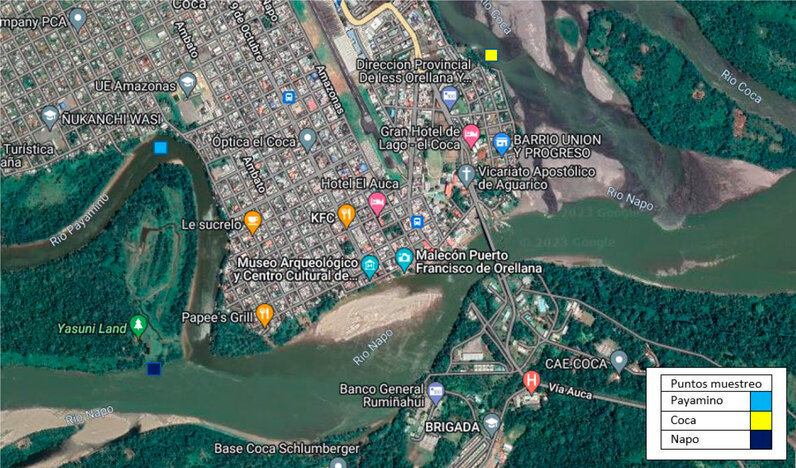
Figure 1. Geography of the surveyed area and sampling points (Google Maps).
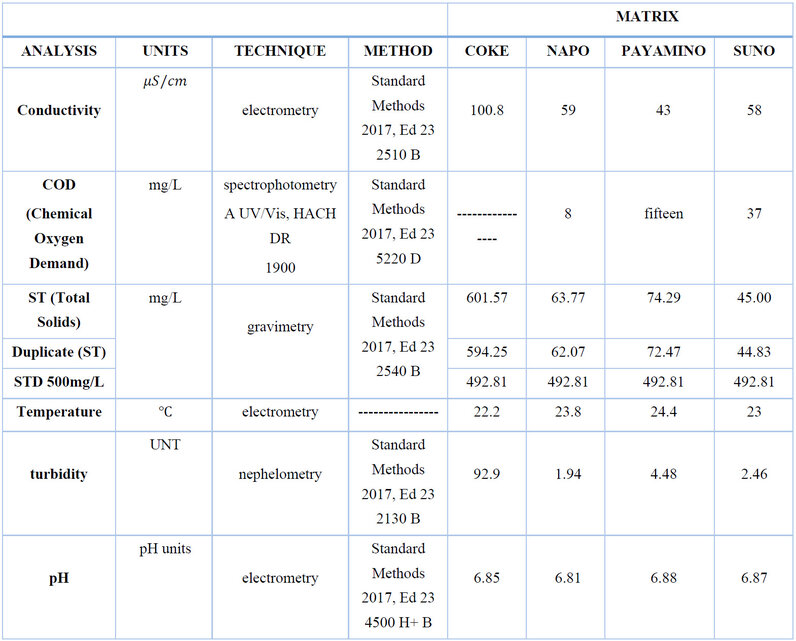
Table 1. Results were obtained by measuring the physical-chemical parameters with the different matrices of the principal rivers of Orellana and Loreto.
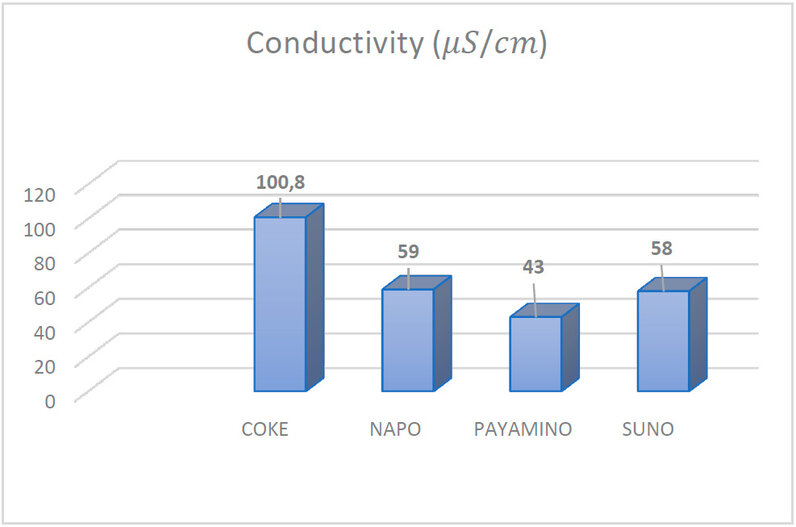
Figure 2. Conductivity results of the four water rivers.
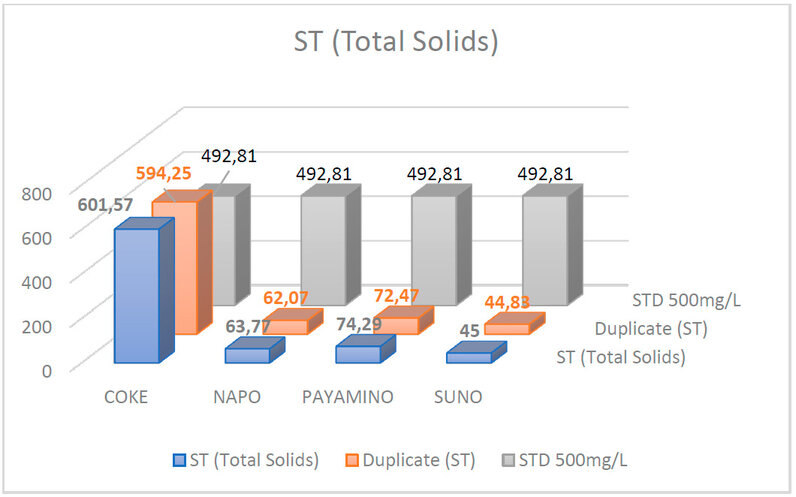
Figure 3. Total solids results.
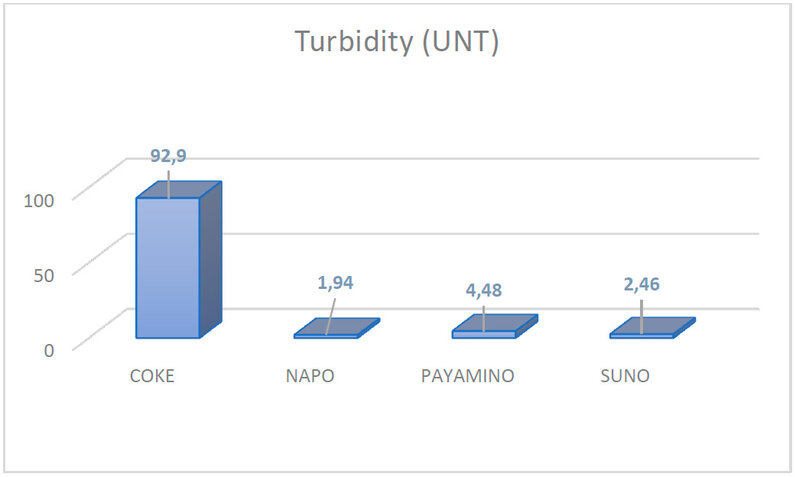
Figure 4. Turbidity results.
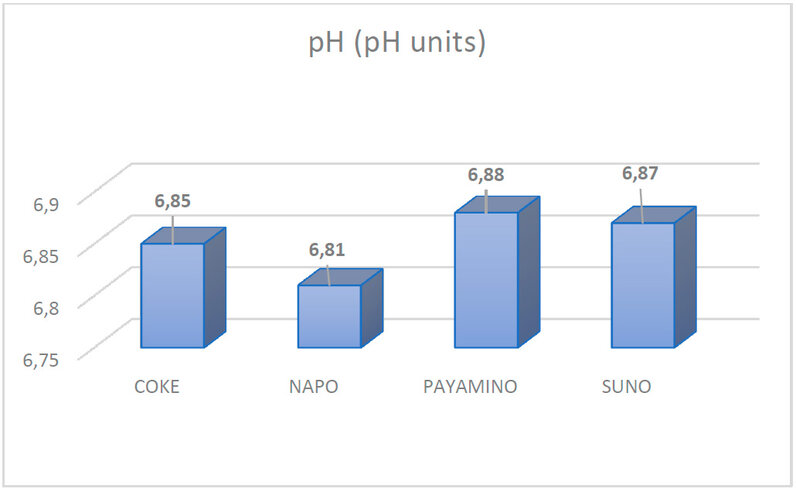
Figure 5. pH results.
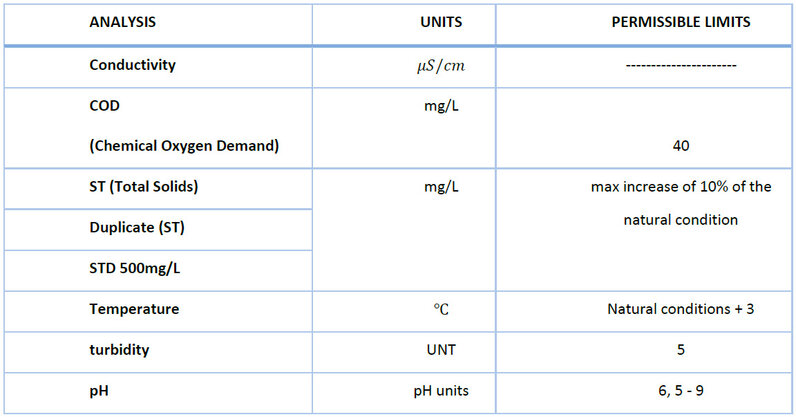
Table 2. According to ANNEX 1 OF BOOK VI of TULSMA, there are permissible limits for quality control of river waters.
Within the framework of the present investigation, the analysis of physicochemical parameters was carried out. This was done in water samples from the rivers analyzed. Parameters evaluated included pH, temperature, COD, electrical conductivity, turbidity, and STD.
The results revealed that the pH of the water of the analyzed rivers varied between 6.81 and 6.88, indicating a slightly acid range. The recorded temperatures oscillated between 22°C and 24°C, reflecting conditions typical of the region's rivers during the sampling season. Regarding COD, values ranging between 8 and 37 mg/L were found, indicating adequate levels for the maintenance of aquatic life. The electrical conductivity ranged from 43 to 100 µS/cm, demonstrating a high presence of dissolved substances in the rivers analyzed. Regarding turbidity, values ranging between 1 and 92 NTU were observed, indicating that the Coca The river is outside the established ranges, compared with the other rivers analyzed, which are within the established ranges.
In general, the results obtained suggest that the water of the Payamino and Suno rivers presents physical-chemical characteristics within the ranges considered adequate for the maintenance of aquatic ecosystems and the supply of drinking water. However, the Coca and Napo rivers present analyses outside the permissible ranges; continuous monitoring and a more exhaustive evaluation are recommended to ensure the maintenance of water quality in the long term and detect possible changes or environmental impacts.
DISCUSSION
The Physicochemical results obtained cannot vary in comparison to the matrix with the duplicate. If the analytical result falls outside the standard control limits, the filtration procedure, analysis, or the control analyte should be reviewed. An important factor may be removing coarse floating particles and submerged agglomerates of materials that are not homogeneous or foreign to the rest of the sample.
Once the results without variations have been obtained, we can compare the quality obtained from the samples, with domestic uses, irrigation, recreational purposes and livestock use, with the standards established in Annexo I of book VI TULSAM "ENVIRONMENTAL QUALITY STANDARD AND DISCHARGE OF EFFLUENTS: WATER RESOURCE.
The results revealed variations in the electrical conductivity values, ranging between 43 μS/cm and 100.8 μS/cm. These findings show the presence of dissolved substances in the rivers analyzed, with the Coca River having the highest conductivity. These results point to the influence of minerals or other substances in the water, which could require further evaluation of its quality and origin.
The Chemical Oxygen Demand (COD) values in the Napo, Payamino and Suno rivers ranged from 8 mg/L to 37 mg/L. All were below the established permissible limit of 40 mg/L. These results indicate an organic load within acceptable limits in the analyzed rivers, crucial for maintaining aquatic life.
The total solids (TS) analyses revealed values ranging between 45.00 mg/L and 601.57 mg/L. The Coca River had the highest value, with the following values. Although these results exceeded the Standard of 500 mg/L, they were within the permissible limit, allowing an increase of up to 10% of the natural condition. Therefore, it is considered that the values obtained are within the acceptable limits regarding the presence of dissolved solids in the rivers analyzed.
The temperature measurements registered values that reflected the environmental conditions typical of the region during the sampling season, ranging between 22.2℃and 24.4℃. These results indicate that the selected rivers present temperatures within the adequate limits for maintaining aquatic ecosystems.
Regarding turbidity, the values obtained varied between 1.94 and 92.9 UNT. These results indicate the presence of suspended particles in the water. The Coca River was the one with the highest turbidity. Although all the rivers analyzed remained within the permissible limit of 5 UNT, except the Coca River, the latter showed a higher load of sediments or suspended particles.
The pH of all the rivers analyzed showed slightly acid values, with results that oscillated around 6.81 pH units. This condition may have implications for certain aquatic species and highlights the importance of monitoring and regulating acidity levels in the water.
CONCLUSIONS
The results indicate that the Payamino and Suno rivers present physicochemical parameters within the ranges considered adequate for maintaining aquatic ecosystems and the drinking water supply. However, the Coca and Napo rivers show values outside the permissible ranges in some parameters analyzed. Therefore, continuous monitoring and thorough evaluation are recommended to ensure long-term water quality maintenance and to detect possible environmental changes or impacts. These conclusions support the need to implement appropriate management measures to preserve water quality in the analyzed rivers and ensure the sustainability of aquatic ecosystems.
For future researchers interested in determining the contamination of the main Loreto-Coca rivers through physicochemical parameters, a careful selection of parameters, establishment of strategic sampling points, adequate collection and preservation of samples, rigorous statistical analysis of the data and a contextualized interpretation of the results.
REFERENCES
1. Alcantara, M. G. The definition of health of the World Health Organization and interdisciplinarity. sapiens. University Research Journal. 2016, 93-107.
2. Gonzalez-Alonso, S. & Esteban-Hernandez J. Water contamination in sources near Bolivian oil fields. Panama Public Health Magazine. 2010, 235–43.
3. Silva, T.T., Santo K.S., Matsumoto, S.T. & Ribeiro, J. Monitoring of the water quality of the foz of Santa Maria da Vitória river and the Vitória Bayes, by systematic studies of physical-chemical and biological parameters. 2018, 1373-1392.
4. Baque-Mite, R., Simba-Ochoa, L., González-Osorio, B., Suatunce, P., Diaz-Ocampo, E. & Cadme-Arevalo, L. Quality of water intended for human consumption in a canton of Ecuador. Unemi Science Magazine. 2016, 109-117.
5. Morales, J. & Barroso, J. Construction of knowledge about the use, consumption and contamination of water. Conceptions of first-year high school students. 2012, 15.
6. Loayza, J. L. NarrativesTransmedia to raise awareness about the mining contamination of rivers in Ecuador: A review for environmental awareness.Visual Review International Visual Culture Review. 2022, 1–8.
7. Pabón, S. E., Benítez, R., Sarria, R. A., & Gallo, J. A. Water contamination by heavy metals, analysis methods and removal technologies. Between Science and Engineering. 2021, 1909.
8. Silva, R. F., Santos, J. V. & Pires, C. K. Analysisof the physical-chemical parameters of groundwater in the Enseada das Gaivotas neighborhood. 2021, 99-110.
9. April, J. & Weapons-Chugcho P. A. Water quality of the Puyo river and tributaries, Pastaza, Ecuador. Technology and water sciences. 2021, 379-417.
10. Jacoboski B. K. & Fachinetto, J. Quality water assessment of the Matadouro Stream, Ijuí, Rio Grande do Sul, by physicochemical parameters and the Allium cepa test. Eng Sanit Ambient. 2022, 489-497.
11. Sousa, A.M., Nunes, C. R., Santos L. F. & Araújo T.M. Multivariate Statistical Analysis Of Physico-chemical And Microbiological Parameters And Calculation Of The Water Quality Index Of "Lagoa De Cima". Geosciences. 2022, 689-702.
12. Castillo, Y. M., Fontalvo, J. A. & Borja, I. M. Bacteriological quality of the water of the manaure and casacara rivers, department of Cesar, Colombia. 2018, 46.
13. Prat, N., & Munne, A. Biomonitoring of water quality in Iberian rivers: Learned lessons.limnetics. 2014, 3.3
14. Sierra, J., Jaime, A. & Mora, A. Monitoring of physicochemical parameters in the upper basinof the Bogota river. New Granada Science and Engineering. 2002, 23-30.
15. Gutierrez-Fonseca, P. E. & Ramirez, A. Ecological evaluation of streams in Puerto Rico: Major threats and evaluation tools. Hydrobiology. 2016, 433-441.
16. Mora, A., Jumbo-Flores, D., Gonzalez-Merizalde, M. & Bermeo-Flores, S. A. Heavy metal levels in sediments from the Puyango river basin, Ecuador. Rev Int Contam Ambient. 2016, 385-397.
17. APHA, AWWA & WPCF. Standardized methods for the analysis of drinking and wastewater. (APHA,1992).
18. Caho-Rodriguez, C. & Lopez-Barrera, E. A. Determination of the Water Quality Index for the western sector of the Torca-Guaymaral wetland using the UWQI and CWQI methodologies. 2017, 35-49.
19. Tomas, P., & Moreno, J. L. Assessment of the ecological status of rivers of the Ebro Basin using the trophic macrophyte index IVAM-G (Macroscopic Aquatic Vegetation Index). 2016, 219-233.
20. Morell-Bayard, A.D., Bergues-Garrido, P. S. & Portuondo, F.. Assessment of the physicochemical parameters of the waters of the San Juan River in the wet and dry periods of 2014. 2015, 1-12.
21. Garzon, J. M., Rodríguez-Miranda, J. P. & Hernández-Gómez, C. Contribution of bioremediation to solve pollution problems and its relationship with sustainable development. 2017, 309-318.
22. Delgadillo, A. E., & Gonzalez, C. A. Phytoremediation: an alternative to eliminate contamination. 2011, 597-612.
23. Acosta, R., Rios, B., Rieradevall, M. & Prat N. Proposal for an evaluation protocol of the ecological quality of Andean rivers (CERA) and its use in two basins in Ecuador and Peru. 2009, 35-64.
24. Moreno, J. L., Navarro, C. & Heras, J. Generic index of aquatic vegetation (IVAM) for a rapid assessment of ecological quality of Spanish rivers: Taxonomic resolution and application to Castilla-La Mancha region. 2005, 48-53.
25. Meneses-Campo, Y., Castro-Rebolledo, M. I. & Jaramillo, A. M.. Comparison of water quality between two andean rivers by using the BMWP/COL. and ABI. 2019, 299-310.
26. Prat, N., & Munne, A. Biomonitoring of water quality in Iberian rivers: Learned lessons. Limnetica. 2014, 47-64.
27. Castillo, Y. M., Fontalvo, J. A. & Borja, I. M. Bacteriological quality of the water of the manaure and casacara rivers, department of Cesar, Colombia. 2018, 46.
28. Mendoza, Y. I., Perez, J. & Galindo, A. A. Evaluation of the contribution of the aquatic plants Pistia stratiotes and Eichhornia crassipes in the treatment of municipal wastewater. Technological information , 2018, 205-214.
29. Bres, P., Crespo, D., Rizzo, P., & Rossa, R. Ability of the macrophytes Lemna minor and Eichhornia crassipes to remove RIA nckel. Agricultural Research Journal. 2012, 153-157.
30. Mayz-Figueroa, J. & Manzi, L. Hydrocarbonlastic bacteria of the genus Pseudomonas in the rhizosphere of Samanea saman (Jacq.) 2017, 29-37.
31. Ferrera-Cerrato, R. Bioremediation processes for soil and water contaminated by petroleum hydrocarbons and other organic compounds. 2006, 179-187.
Received: 9 October 2023/ Accepted: 15 January 2024 / Published:15 February 2024
Citation. Allauca P J, Lopez P C, Daza J, Chamba J. Description of the primary Loreto-coca river contamination through the measurement of physicochemical parameters. Revis Bionatura 2024; 1 (1) 7. http://dx.doi.org/10.21931/BJ/2024.01.01.7
Additional information Correspondence should be addressed to [email protected] / [email protected]
Peer review information. Bionatura thanks anonymous reviewer(s) for their contribution to the peer review of this work using https://reviewerlocator.webofscience.com/
All articles published by Bionatura Journal are made freely and permanently accessible online immediately upon publication, without subscription charges or registration barriers.
Publisher's Note: Bionatura stays neutral concerning jurisdictional claims in published maps and institutional affiliations.
Copyright: © 2023 by the authors. They were submitted for possible open-access publication under the terms and conditions of the Creative Commons Attribution (CC BY) license (https://creativecommons.org/licenses/by/4.0/).
